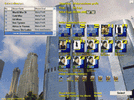MI-6
British Secret Intelligence Service SIS

MI6 |
MI6 (originally Military
Intelligence 6) is the British Secret
Intelligence Service. Often known by its initials, SIS is
one of the British secret service agencies.
SIS has a remit to conduct espionage activities overseas,
as opposed to MI5 which is charged with internal security
within the United Kingdom. It was founded (along with
MI5) as part of the Secret Service Bureau in 1909. Its
first director was Sir Mansfield Smith-Cumming, from
whose initial the codename used by him and all subsequent
directors of SIS, "C" (not "M" as in
the James Bond stories), originated (he usually dropped
the "Smith").
Its first significant test came
with the First World War, during which it had mixed
success. It was unable to penetrate Germany itself, but
had some significant successes in military and commercial
intelligence, achieved mostly with agent networks in
neutral countries, occupied territories, and Russia.
After the war its resources were greatly reduced, and the
organisation became MI6 in 1921. It began to operate
mainly through a system of sometimes-grudging
co-operation with the diplomatic service. Most embassies
acquired a "Passport Control Officer" who was
in fact the SIS head for that country. This gave SIS's
operatives a degree of cover and diplomatic immunity, but
the system probably lasted too long and was an open
secret by the 1930s. In the immediate post-war years and
throughout most of the 1920s, SIS was preoccupied with
Communism, and Communist Russia in particular. Sidney
Reilly was loosely associated with SIS until his capture,
and SIS sponsored and supported both his and Boris
Savinkov's attempts to bring down the Communist regime,
in addition to running more orthodox espionage efforts
within Russia.
Cumming died (in his office) in
1923 and was replaced as "C" by Admiral Hugh
'Quex' Sinclair, whom historians agree to have been far
less effective as a director. He was not incompetent, but
he did not have the advantage of Cummings' force of
personality, and was unable to command the respect and
obedience of his men as effectively as Cumming had.
Along with the rest of the intelligence community and the
wider government, SIS switched focus in the 1930s to Nazi
Germany. Again its success was rather modest; although it
did acquire several quite reliable sources within the
Government and also the German Admiralty, its information
was probably less comprehensive than that provided by the
rival network of Robert Vansittart, the permanent
undersecretary at the Foreign Office.
'Quex' Sinclair died in 1939 and was replaced as
"C" by Lt. Col. Stewart Menzies. Menzies was
another run-of-the-mill chief; by common opinion, SIS did
not have a head of Cummings' calibre until Dick White, in
the post-war era.
During the Second World War, SIS was overshadowed in
intelligence terms by several other initiatives,
including the massive cryptanalytic effort undertaken by
GC & CS (the bureau responsible for interception and
decryption of foreign communications) at Bletchley Park,
the extensive "double-cross" system run by MI5
to feed misleading intelligence to the Germans, and the
work of the Photographic Reconnaissance Unit. It was also
affected by the inflammatory activities of the Special
Operations Executive, which tended to increase the danger
to its own agents. Its most famous operation of the war
was a spectacular failure known as the Venlo incident
(after the Dutch town where much of the action took
place), in which SIS was thoroughly duped by agents of
the German secret service, the Abwehr, posing as
high-ranking Army officers involved in a plot to depose
Hitler. After a series of meetings between SIS agents and
the 'conspirators' at which SS plans to abduct the SIS
team were shelved due to the presence of Dutch police, a
meeting took place without a police presence, and two SIS
agents were duly abducted by the SS. This failure
tarnished the service's reputation considerably.
Since 1997? SIS activities have been subject to scrutiny
by Parliament's Intelligence and Security Committee.
The SIS headquarters since 1995 is at Vauxhall Cross,
located in Vauxhall in London, on the bank of the River
Thames beside the Vauxhall Bridge.
The fictional spy James Bond supposedly worked for SIS
(though the books by Ian Fleming should not be taken too
seriously), and in fact the SIS building features in some
of the Pierce Brosnan films.
Text is available under
the terms of the GNU Free Documentation License
|
